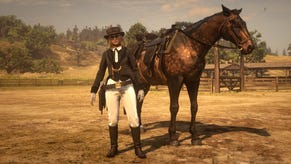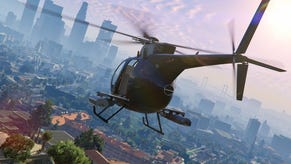Blackwater and beyond: Red Dead Redemption 1/2 directly compared
1899 vs 1911, 2010 vs 2018.
Spoiler warning: this article concentrates on an area of the Red Dead Redemption 2 game map that is mostly inaccessible to players who have not finished the game. If you want to remain completely unspoiled, close the page now.
It's been eight years since the first Red Dead Redemption. Set in 1911, Rockstar San Diego boldly set out to show America in a process of rapid change. The wild west is depicted on the decline. The frontier is in its twilight days as the modern revolution sets in, paving the way for railroads, electricity and civil commerce. It's far from perfect. A friction between the old and new streaks through John Marston's story. It's a division that flares up starkly in Armadillo town, between the bandits that ride its high streets, and the shop signs that flank them - the sleaze of the saloon bar, and the order of the station across the road.
Rockstar's strength is in stitching such small details together, bringing any landscape, any era, to life. The release of Red Dead Redemption 2 - which is set in 1899, 12 years before the first game - offers a fascinating snapshot of America at an even earlier time. It's a period where outlaw culture - the bandits and highwaymen - is still in full force, and settlements are in a process of growth.
There are location spoilers ahead, so if you are keen to see everything Red Dead Redemption 2 as to offer completely unspoiled, I'd recommend looking away now. Final warning!
Red Dead Redemption 2's world is huge, and filled with surprises. Not least, it turns out, because the original Red Dead Redemption's map - bar the Mexico area - is included in this sequel. It isn't a copy-paste of the original terrain either. Rather, Rockstar gives it a complete overhaul, rebuilding every point of interest to emphasise that regression in time. It's possible to compare the two games this way, to see the touches Rockstar make to preserve historical accuracy. As Red Dead 2 is set 12 years in the past, it means the chronology of the two games must be believable - but that clearly comes with artistic challenges. But on the other hand, RDR2 also shows a huge advance in the RAGE engine itself - so the differences between the two games aren't just about the passage of time in the game world, but in the advances in console technology in ours.
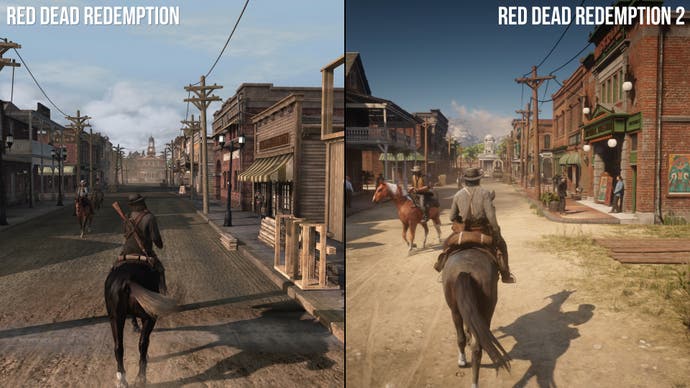
So, to what extent is this spoiler territory? After all, we're dealing with an open world here and even if you don't complete the main storyline, there's nothing to stop you venturing south with only a few missions under your belt. Access to Blackwater and Tall Trees, for example, is available this way, but you're hunted down on sight. Assuming you make it through this alive, travelling further south triggers an automatic death - you're not meant to be in this region too early. But reach far enough into the game, and the map is fully accessible - and we can stack it up against the Xbox 360 game, running at native 4K resolution on Xbox One X. It looks incredible this way - crisp and sharp. On the basis of image quality and frame-rate, it's the best way to play the original game today, though it does have clear technical limits next to the sequel as we'll see.
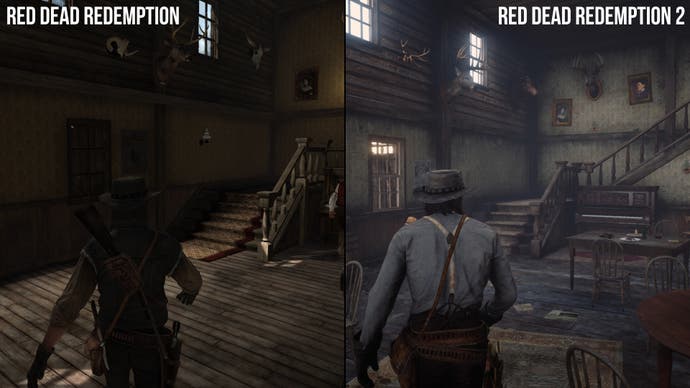
Indeed, while the sequel's set 12 years in the past, the technology realising it is 8 years to the better. The horsepower of current-gen machines allow for everything to be rendered at far greater detail. Higher RAM allocations open the gates to improved texturing, grass transparencies, and animations. Atmospheric effects like volumetric lighting produce a more accurate sense of spatial depth, while materials are rebuilt to suit the new lighting model. Not to mention the game's wildlife, which of course, is a big focus on the latest RAGE tech.

The sequel overcomes many of the original game's limits. Bearing in mind Red Dead Redemption was only first designed to be seen at 1280x720, quadrupling the pixel count to 4K on X shows its rough edges. In big towns, you get half - and even quarter - frame-rate animations on characters in the distance. That slow update creates a bizarre stutter effect to movement far away - one we weren't meant to catch back in 2010. Of course, all of that is changed for the better in the sequel, with its vastly pushed out LODs. Likewise for shadow filtering, an obvious weak point on the original, with shade filling out past an obvious cascade on the ground.
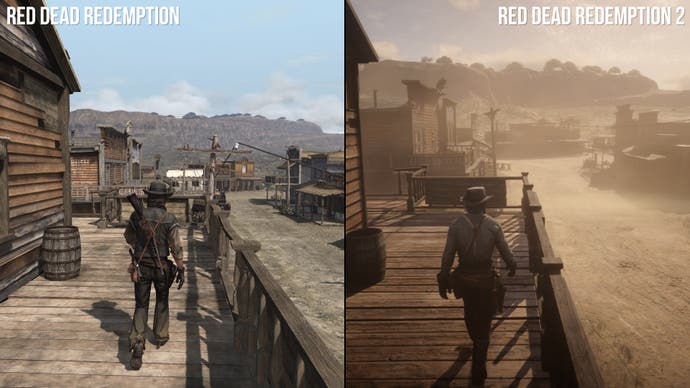
Armadillo's detailing is similar between both games - Red Dead Redemption 2's winds billow dust through the high street, but in matching the time of day, many of the same buildings are clearly fixed in place. The bank, general store, gunsmith and general practice are unmoved - only now they're decorated with more crates, and new store fronts. Small details are added to the station too. The sequel boasts swinging doors on the front porch - another example of technical progress that possibly flouts the series' chronology. It's entirely missing in the first game, but it's easy to simply see RDR2 as the definitive rendering of the scene - the way it should be.
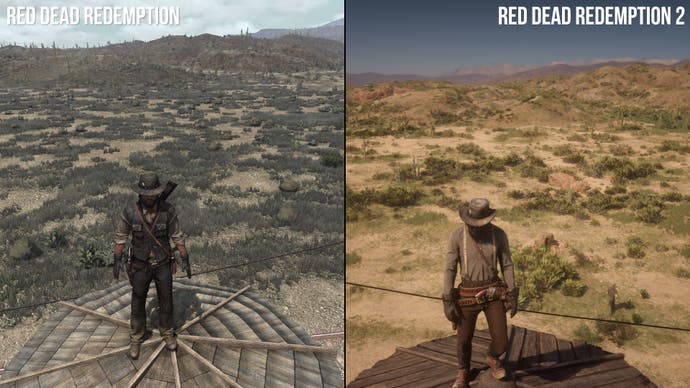
From high-up, the surrounding terrain sees a grand change too. Draw distances stretch out much further in the new game and it replaces the low-res grass tufts of the original with neater pockets of fauna - all properly shaded. Cacti and rocks are introduced too, while dust spreads more thickly across the plains- lit by a morning sun to create a fuller, denser appearance. It's strange to see the rocks and hill mounds adjusted significantly towards the horizon, mind. It shows Rockstar really did go in to recreate everything afresh, with the original landscape used merely as a template. Overall though, it's still accurate enough to the landscape we saw 12 years prior.
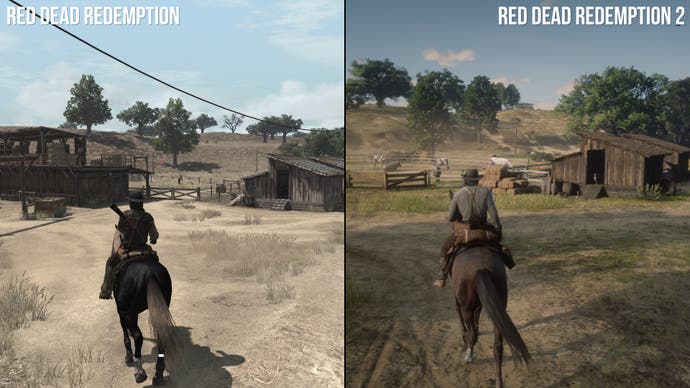
The passing of time is easier to trace in areas where people have settled. MacFarlane's Ranch is a great example. Red Dead 2 has it covered in crisp green grass with flowers in bloom, a seasonal change that contrasts with the arid, dry tufts of the original. Between the two points in time, its staff have cut trees down too, opening the line of sight across the ranch. This is key - the sequel shows this area still in development and an entire barn is simply missing in the sequel. A dust track leads to where it will be - but it's a spot that will see a lot of change in the coming years.
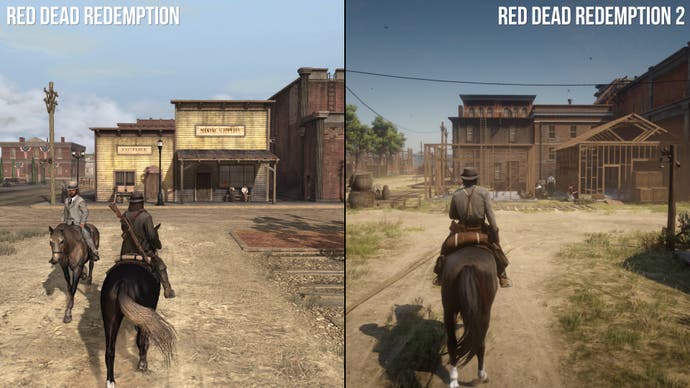
Blackwater town takes this even further, a settlement that's already well developed in the original Red Dead. This is where we see some unusual choices from Rockstar - some of which make sense, others less so. On approach, major details are deliberately missing. Its train station and tracks have yet to be built, and the Mininc Supplies store ahead is being propped up with wood supports. The real estate and law office stick in place too, but bizarrely, the buildings themselves are radically redesigned in their material. Taking the Blackwater Hotel as an example, it's sports redesigned wood and glass front, with arched stone windows above. It looks vastly better in the sequel, but should it?
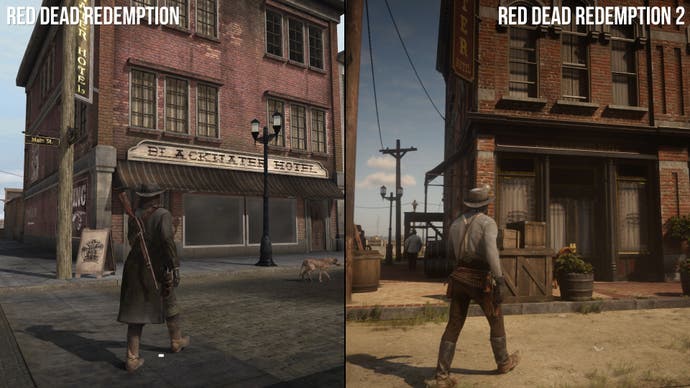
There's another example straight ahead: the main Blackwater clocktower is completely redesigned. Red Dead 2 renders this with a wooden fence up-front that's removed by the time of the original game, where a gazebo stands instead. The height of the clock portion is lowered in RDR2, and the building's base is wider. Again, it's hard to see such a radical change like this occur over the course of 12 years - the building itself is rebuilt from scratch. It's a case of the sequel's upgraded RAGE tech, and a new art team stepping in, taking liberties to revise the past to simply make a better looking asset. That is, even if it doesn't fit in squarely with original's design.

It's a mixture then. The question is, where do you draw the line between a technical progression, and a change that fits into the series' timeline? On balance it's great to see all these spots embellished. We are nitpicking of course, but the town areas are a goldmine for seeing how deeply Rockstar has invested in its attention to detail. And for a game so particular about its history, it shows the shift in culture and technology in a way few other game series have achieved.
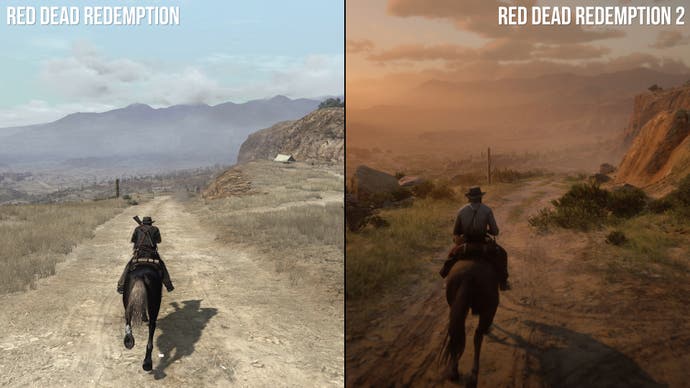
Perhaps the last stop on the tour into Red Dead Redemption's past is the woodlands. Taken at a canter, the Tall Trees area is genuine visual treat; the flora, fauna are meticulously designed here, and the interaction with a mid-afternoon light goes far beyond the original. A light shaft effect worked well for the first game - and the forest had a surprisingly dense appearance for the time. It was well executed, but goes to a whole new level for RDR2. Proper volumetric lighting fills in between each tree, and the ground level is enriched by a fuller swathe of grass and idle woodland animals.
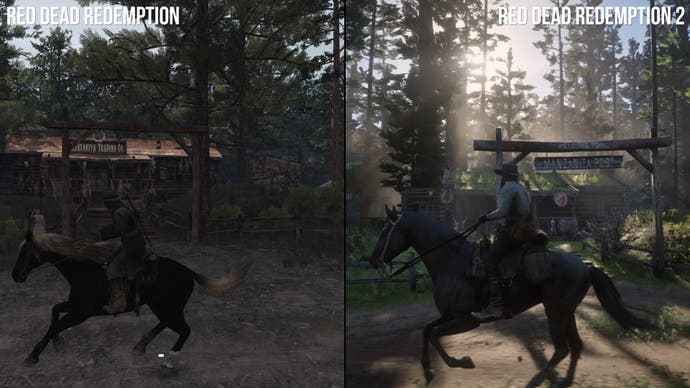
Passing the Manzanita post, it's easy to see this as a firmer fixture of the world than we might have expected. The most substantial change is to the greenery surrounding it though, certainly on a technical level. With the addition of post-effects like blur as we ride, Red Dead Redemption 2 frames a beautiful scene with a more photographic sensibility - avoiding the stark, overly raw look to the original's grass textures and repeated tree assets. Gone are the small cases of LOD pop-in we had in the first game too, giving us a clear view of fully rendered thicket ahead.

Rockstar's choice to revisit old towns, woodlands, and deserts in Red Dead Redemption 2 offers a rare opportunity in analysing graphics tech. Jumping from 2010 to 2018, it draws a clear line between two huge technical milestones of their eras. The first game is based squarely on last-gen technology, but maximised the potential of Xbox 360 and PS3 with a convincing open-world ode to the dying wild west. The sequel, appropriately, uses superior PS4 and Xbox One hardware to show an untamed wilderness - one where forests and deserts are replete with organic detail. What's also clear is Rockstar's trademark attention to detail is more often than not, consistent - and it's the stacking up of these small points that makes the picture complete.
Not every change makes sense in the chronology of Red Dead Redemption 2's lore, but as a technical pursuit it's astonishing to see the before-and-after. As a glimpse into the past using present-day technology there isn't anything quite like it.







